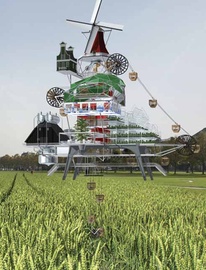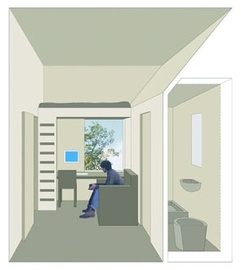Value-based transformation
The turn of the millennium has been a frustrating event for many futurists. It was a milestone for many future visions, and as the date came close, it was all the more apparent that their visions were not going to come true. In 1997 The New York Times wrote: “Our goals as a people are not these pie-in-the-sky objectives that people grew up with in the 50’s. They settle now for a house in the suburbs and to hell with the Moon. What’s the point of building monorails if we can hardly get the car to work?” (Schiesel 1997).
The count down to the millennium was not so much accompanied by celebration of what had been accomplished as by fear of a ‘millennium bug’ that would make electronic equipment crash. Another sign of the general resentment among futurists was seen when Walt Disney decided to go retro when renewing the theme park Tomorrowland in 1997. It marked a profound shift for a man who saw himself as the middleman between industry and the public when it came to communicating ideas of the future.
Others have found the mark of a new millennium to be an occasion to set new goals and change the world for the better. Best known may be the UN Millennium Project which is committed to reducing extreme poverty and achieving universal primary education by 2015. Designers have taken up the challenge and have experienced a shift towards philanthropic design. MIT is working on a One-Laptop-Per-Child project and Philips has developed a stove to reduce indoor pollution in developing countries. Others, like the prominent D.school at Stanford University and the Design Futures MA program at the Goldsmiths University of London, look at the underlying structures of society to help alleviate poverty. Competitions and awards, like the Buckminster Fuller Challenge, the Index Awards and the IDSA 2050 conference, have also played an important role in promoting and building a philanthropic design community.
Sustainable systems
Humanistic values are not new to the field of design and have roots going back to the mid-19th century, as described earlier. Particularly, in the 1970s there was a surge of attention with the release of the book The limits to Growth (1972), which was a broadly acknowledge warning on the well-being of earth. Among others, the designer Victor Papanek voiced his concern to the design community. Still, sustainability did not catch momentum until the 1990s when it once again became part of the public debate (Morelli 2006), and the optimistic belief in technological progress was replaced with a general concern about the state of the planet and society.
One reason may be that designers have had limited powers to address such challenges. They have traditionally been confined to a narrow design brief, which does not leave much room for pursuing a fundamental change of the world. The most direct and feasible way for designers to make a difference, was for several decades considered to be through the selection of more environmental friendly materials. However, since the 1980s designers have expanded their influence and are therefore also able to address the challenges in more complex ways, such as the product/service system (PSS) approach. The PSS approach takes the whole system that surrounds the production and use of a product as the object of design. The purpose is to reduce the ecological footprint and create empowered communities. It often involves changing people’s habits and attitudes towards products, as may been seen in Manzini’s (2003) solution-oriented scenario.
Today, designers are increasingly looking for real solutions to real problems, and are attempting to transcend the narrow business objectives which typically frame design projects. This is partly made possible by designers’ increased standing in organisations, and partly because consumers, society and businesses have become more sensible to humanistic and sustainable values.
Critical European foresight
At the time that Herman Kahn introduced futures thinking in the US, there had long been a tradition for studying the future in France. In the 1930s Gaston Berger created a research centre in Paris for philosophical studies of the future. He invented the term ‘prospective’ for the study of possible futures (Berger 1964). However, while the American future movement quickly entered the international business world, the philosophical French futurists never made it to the same level. Instead they prepared the ground for a distinct European academic movement for technology assessment which took off in 1980s and primarily assists public institutions in policy-making (Schot & Rip 1997). The academic movement was based on a critical and constructivist sociological inquiry into society and technology, and is particularly purposeful in areas of technology where markets are non-existing or where there are conflicting views of the value of the technology, e.g. nano-, bio- or information technology (M. S. Jørgensen et al. 2009).
A small group of researchers have introduced a critical approach to understand the socio-technical aspects at the level of people and product in the area of design. They do not take for granted that people have certain needs and that products fulfil a particular function, but rather investigate how these meanings are constructed in a broader perspective. In 2002 a masters program was started at the Technical University of Denmark, which teaches design students socio-technical theory and provides new approaches to inquiry about design-related problems. The understanding of people’s needs also opens up new ways of addressing sustainability and reducing the consumption of resources in people’s everyday lives. The field is just starting to find its own feet and the Sustainability Department of Industrial Design at Delft University of Technology is among others finding ways to implement such an approach.
Public services
In 2005 Hilary Cottam was honoured with the title “Designer of the Year” by the Design Museum, United Kingdom, to the surprise of the design community. She was not a trained designer of ‘things’ but instead applied a design approach to social issues. In close collaboration with public authorities and with the involvement of the local actors, she had facilitated redesign of schools, prisons and healthcare services. For the prison project she put together a multi-disciplinary team of architects, criminologists and prison governors to develop an alternative prison for the 21st century. The final concept lowered the cost of surveillance and freed up resources for educational programs for the inmates to combat high levels of re-offence.
For architects, the twilight zone between political, business and social issues is a territory that they know well from designing public buildings and spaces. They have a tradition for applying a holistic approach and architects are increasingly using ethnographic and designerly ways of dealing with social issues. The winning proposal of a competition on the ‘Future Library’ in 2005 at a Danish school of architecture, for example, was based on user probes, design games and personas.

Shared vision
The fusion of methods from design and social action is another interesting constellation in the pursuit of radical visions and concepts. For example, it is not unusual for business and design consultancies to use large visualizations – murals – as a vehicle for developing common vision among employees and stakeholders. The design event Index 2005 in Denmark used visual facilitators to develop common visions of how to “improve the quality of life” and mixed them with ethnographic methods to understand people’s everyday lives. The approach is taken from the field of social action, which has a long tradition of making murals to express the history, hopes and future of minorities or social groups. These political works of art were particularly popular in Mexico and the United States at the time of the financial crisis in the 1930s. The depiction of common futures had a revival during the social movement in the 1960s and murals have recently been used to portray scientific ignorance of nuclear energy and genetically engineered plants (Horn 2006). Within the field of design, the design researchers Paul Hekkert (2001) and Erik Lerdahl (2001) are creating methods for developing values and translating them into concrete product proposals.
Extract from PhD thesis “Everyday-Oriented Innovation”


